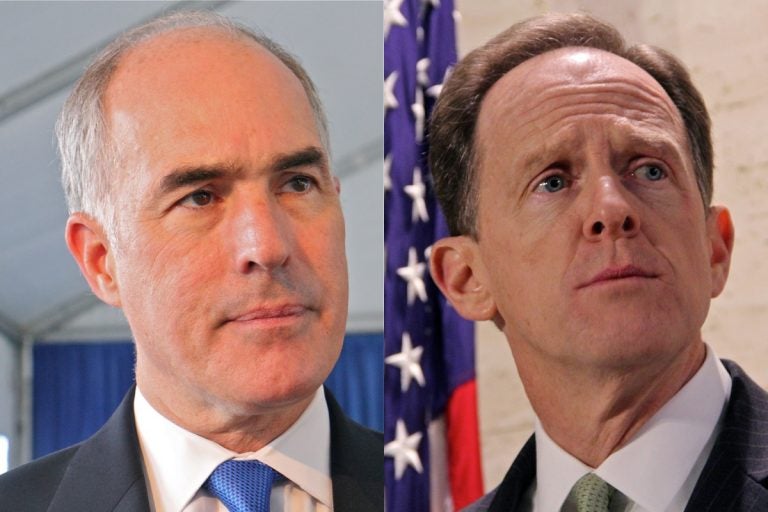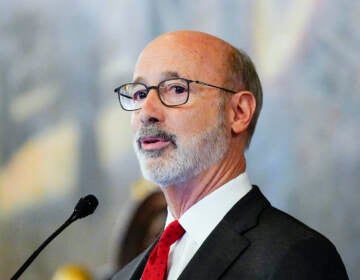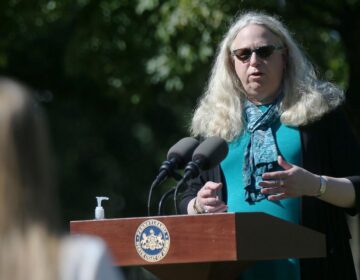Pa., Del. among long list of troubled nursing homes revealed by Casey and Toomey
The federal government for years has kept under wraps the names of hundreds of nursing homes around the country found by inspectors to have serious health and safety concerns.

U.S. Senators Bob Casey and Pat Toomey of Pennsylvania. (Emma Lee/WHYY)
The federal government for years has kept under wraps the names of hundreds of nursing homes around the country found by inspectors to have serious ongoing health, safety or sanitary problems.
Nearly 400 facilities nationwide had a “persistent record of poor care” as of April, but they were not included along with a shorter list of homes that get increased federal scrutiny and do have warning labels, according to a Senate report released Monday.
Budget cuts appear to be contributing to the problem by reducing the money available for the focused inspections that are required for nursing homes on the shorter list, according to documents and interviews.
The secrecy undermines the federal commitment to ensure transparency for families going through the difficult process of finding a nursing home for a loved one and raises questions about why the names of some nursing homes are not disclosed while others are publicly identified, according to two senators who released the report on Monday.
“We’ve got to make sure any family member or any potential resident of a nursing home can get this information, not only ahead of time but on an ongoing basis,” said Sen. Bob Casey, D-Pa., who along with Sen. Pat Toomey, R-Pa., issued a report on the issue.
“When a family makes the hard decision to seek nursing home services for a loved one, they deserve to know if a facility under consideration suffers from systemic shortcomings,” said Toomey.
The senators released a list provided them by the Centers for Medicare and Medicaid Services, or CMS, of nursing homes with documented problems whose names were not publicly disclosed by the government.
The report and list were provided exclusively to The Associated Press and to PennLive.com.
About 1.3 million Americans are nursing home residents, cared for in more than 15,700 facilities. The senators’ report noted that problem nursing homes account for about 3%.
CMS does publicly disclose names of a smaller group of about 80 nursing homes that are getting special scrutiny to help them resolve documented quality problems. They’re in what’s called the Special Focus Facility program, which is more than 20 years old. Nursing homes that don’t improve can be cut off by Medicare and Medicaid. But if the nursing home resolves its problems, it “graduates” from the program.
Consumers can identify special focus facilities on the government’s Nursing Home Compare website by looking for an icon shaped like a small yellow triangle that resembles a traffic “caution” sign. Also, the website does not display starred quality ratings for the special focus facilities. Usually, nursing homes receive from a low of one star to the highest quality score of five stars.
But there’s no similar visibility for the much bigger group of some 400 nursing homes, whose problems have placed them on the official list of “candidates” for the special focus program.
These facilities “qualify for the program because they are identified as having a ‘persistent record of poor care’ but are not selected for participation as a result of limited resources at (CMS),” said the report from Casey and Toomey.
“Despite being indistinguishable from (special focus nursing homes) in terms of their qualifications, candidates are not publicly disclosed,” the report added.
In a letter last month to Casey, CMS Administrator Seema Verma singled out federal budget problems as a contributing factor.
“The total number of (special focus) slots and total number of (special focus) candidates nationally are based on the availability of federal resources,” Verma wrote. She added that as recently as 2010, there were 167 nursing homes in the special focus program and 835 candidates. That’s now down to as many as 88 special focus slots and up to 440 candidates.
She said federal budget cuts in 2014 reduced the number of available slots.
Verma said her agency is evaluating whether it has the legal authority to publicly release the list of “candidate” nursing homes. The Trump administration has asked Congress for more money for health care inspections, but the final amount and how it will be distributed remains unclear.
Consumer groups say disclosure is long overdue.
It might help consumers “know what to avoid,” said Toby Edelman, a senior policy lawyer with the nonprofit Center for Medicare Advocacy. “It might help them avoid facilities that the government is acknowledging are very, very troubled.”
The nursing home industry trade group says it generally supports transparency and takes no position on release of the list. But David Gifford, vice president for quality with the American Health Care Association, said the inspection reports on which the list is based are only one measure, and people should also consider other factors such as staffing levels and clinical outcomes.
Monday’s report from Sens. Casey and Toomey identified several nursing homes from the list of special focus candidates. Among the details:
— In Pennsylvania, a facility failed to ensure that the physician in charge was notified about changes to residents’ conditions, which caused a delay in treatment for one resident who then needed to have surgery and developed an embolism. As of May 29, that facility had one star and a staffing rating of three stars.
— In Delaware, one facility failed to promptly investigate allegations of sexual assault against a staff member, which led to the victim not being referred to the hospital until two days after the incident. The facility also allowed the alleged perpetrator to continue working throughout the investigation with access to the victim. As of May 29, this facility had a five-star rating for both staffing and quality.
WHYY is your source for fact-based, in-depth journalism and information. As a nonprofit organization, we rely on financial support from readers like you. Please give today.




